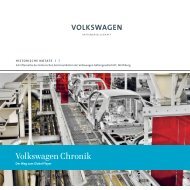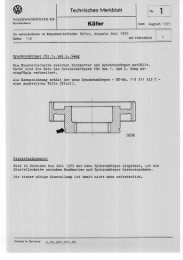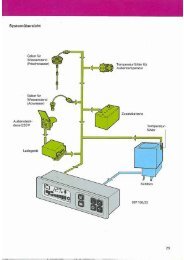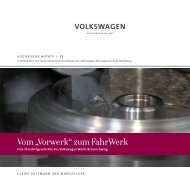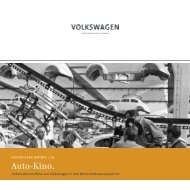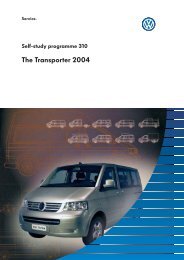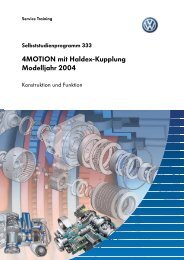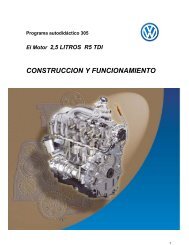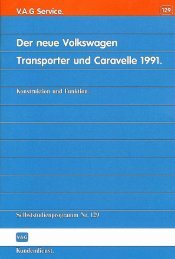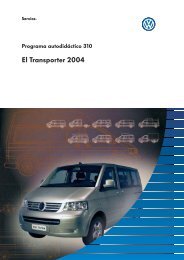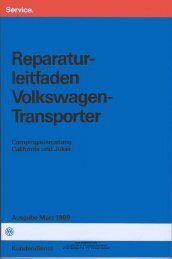HN 2: The British and their Works
HN 2: The British and their Works
HN 2: The British and their Works
Create successful ePaper yourself
Turn your PDF publications into a flip-book with our unique Google optimized e-Paper software.
workforce at the Volkswagenwerk increased from 8,382 in<br />
January 1948 to 8,819 by the end of the year <strong>and</strong> 10,227<br />
in December 1949, the turnover rate fell. Between January<br />
<strong>and</strong> June 1948, 1,407 employees were taken on at the Volkswagenwerk<br />
<strong>and</strong> 1,495 left. In the second half, 758 recruitments<br />
<strong>and</strong> 333 departures were recorded. <strong>The</strong> comparable figures for<br />
1949 were 2,279 <strong>and</strong> 771. In parallel with this, labour productivity<br />
improved considerably. <strong>The</strong> time taken to construct a vehicle<br />
fell from 179 hours in May to 148 in July 1948, reducing constantly<br />
after that to 127 in September 1949. 213<br />
Meanwhile the housing shortage in Wolfsburg remained<br />
an intractable problem. In April 1949 the Volkswagenwerk<br />
negotiated with the Lower Saxony Ministry of Labour for the<br />
construction of several blocks of flats in order to alleviate the<br />
housing problem as a matter of urgency. <strong>The</strong> existing accommodation<br />
was still overcrowded, <strong>and</strong> numerous factory employees<br />
were housed in hutments. Part of the workforce lived outside<br />
Wolfsburg <strong>and</strong> was ferried to work in factory buses. Recruitment<br />
suffered, as before, from the fact that no housing could be<br />
offered to applicants in the foreseeable future. And the existing<br />
accommodation sometimes left a great deal to be desired. In<br />
mid-May 1949 the VW general manager was informed that the<br />
rooms at the Central Hostel for single persons presented "not a<br />
nice picture". Due to the lack of straw, the 275 occupied beds<br />
were topped with palliasses filled with wood shavings. Heinrich<br />
Nordhoff thereupon sanctioned the equipping of the beds with<br />
mattresses. A turnaround in the housing situation came only<br />
with the start-up of private construction work, when in May<br />
1949 the Military Government approved the conclusion of<br />
"Erbbaurecht" (inheritable building rights) contracts. 214<br />
<strong>The</strong> hopes nourished by the Volkswagen management, that the<br />
currency reform would cause the export shackles to fall away,<br />
were not fulfilled. Despite a rising foreign dem<strong>and</strong> for the<br />
universally sought-after Volkswagen, the export business did<br />
not come up to expectations. Exports increased, but they could<br />
not keep pace with the general production growth because sales<br />
abroad were subject to two decisive restrictions. <strong>The</strong> Joint<br />
Import Export Agency (JEIA) only permitted exports against<br />
dollar payments, <strong>and</strong> as of 25th June set the exchange rate at 30<br />
cents per 1 DM. 215 And, as it informed the Commerce & Industry<br />
Group in Frankfurt, it did not intend to treat the export of<br />
Volkswagens in any way differently from other exports. 216 At<br />
the request of the <strong>British</strong> the JEIA had set the price of the<br />
Volkswagen at 800 dollars, so that it could compete internationally<br />
with other small cars. In line with the old rate of 17<br />
cents for 1 Mark, the export price would have been 4,705<br />
Reichsmark. However the new rate resulted in a loss of 1,596 DM<br />
per exported vehicle. General manager Nordhoff, closing<br />
ranks with the Industry Division, pressed for a lowering of the<br />
exchange rate, but in vain. A company report noted in this<br />
connection that the imposition of dollar payments <strong>and</strong> the<br />
existing exchange rate resulted in "an almost complete<br />
throttling of export possibilities". 217 In its endeavours to procure<br />
currency for the necessary imports, <strong>and</strong> thus reduce the costs of<br />
occupation, the <strong>British</strong>-American export policy was ultimately<br />
harming primarily itself because at that time bilateral national<br />
trade agreements were the rule, <strong>and</strong> not many countries were in<br />
a position to import private cars.<br />
86 87<br />
THE DM BOOM



